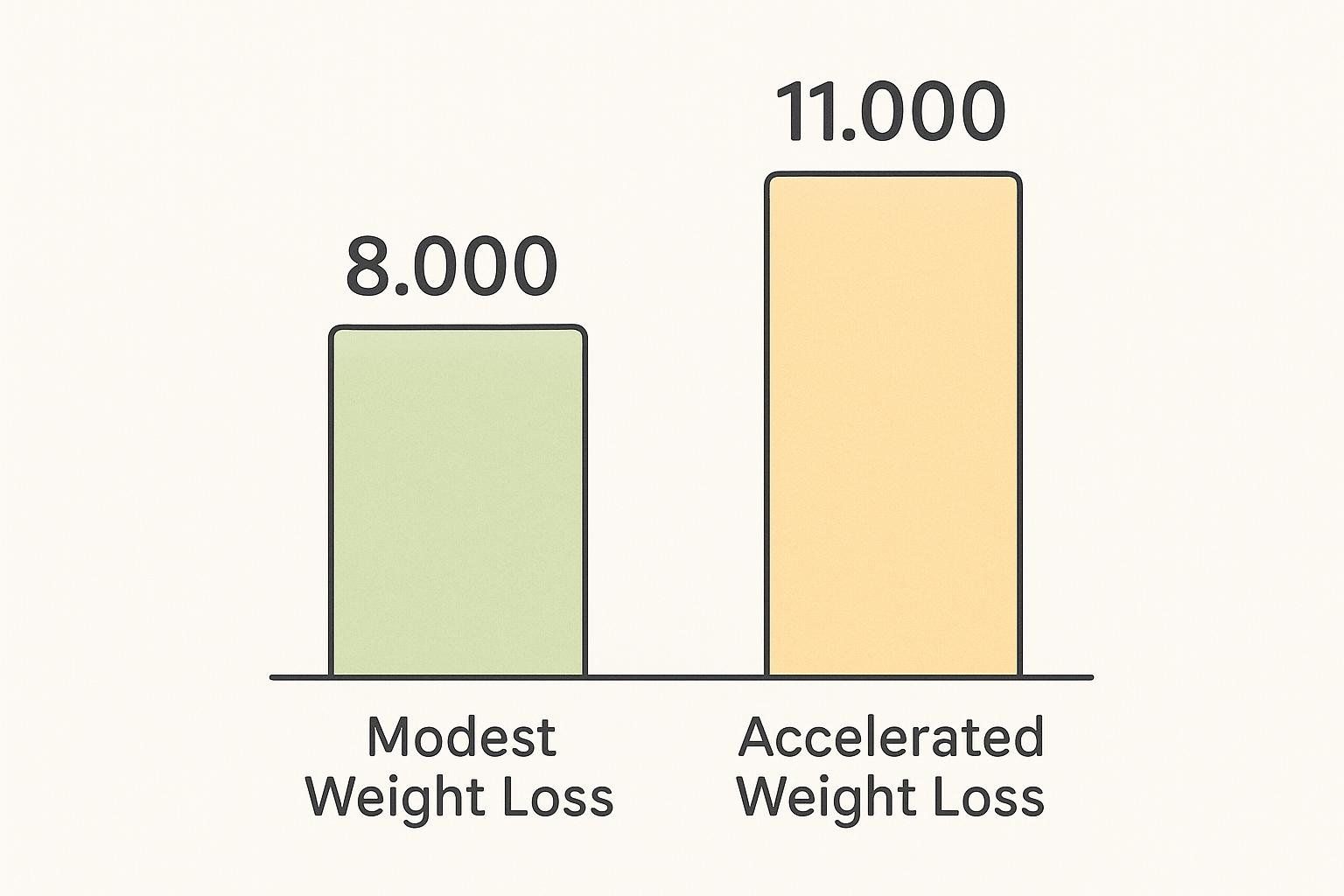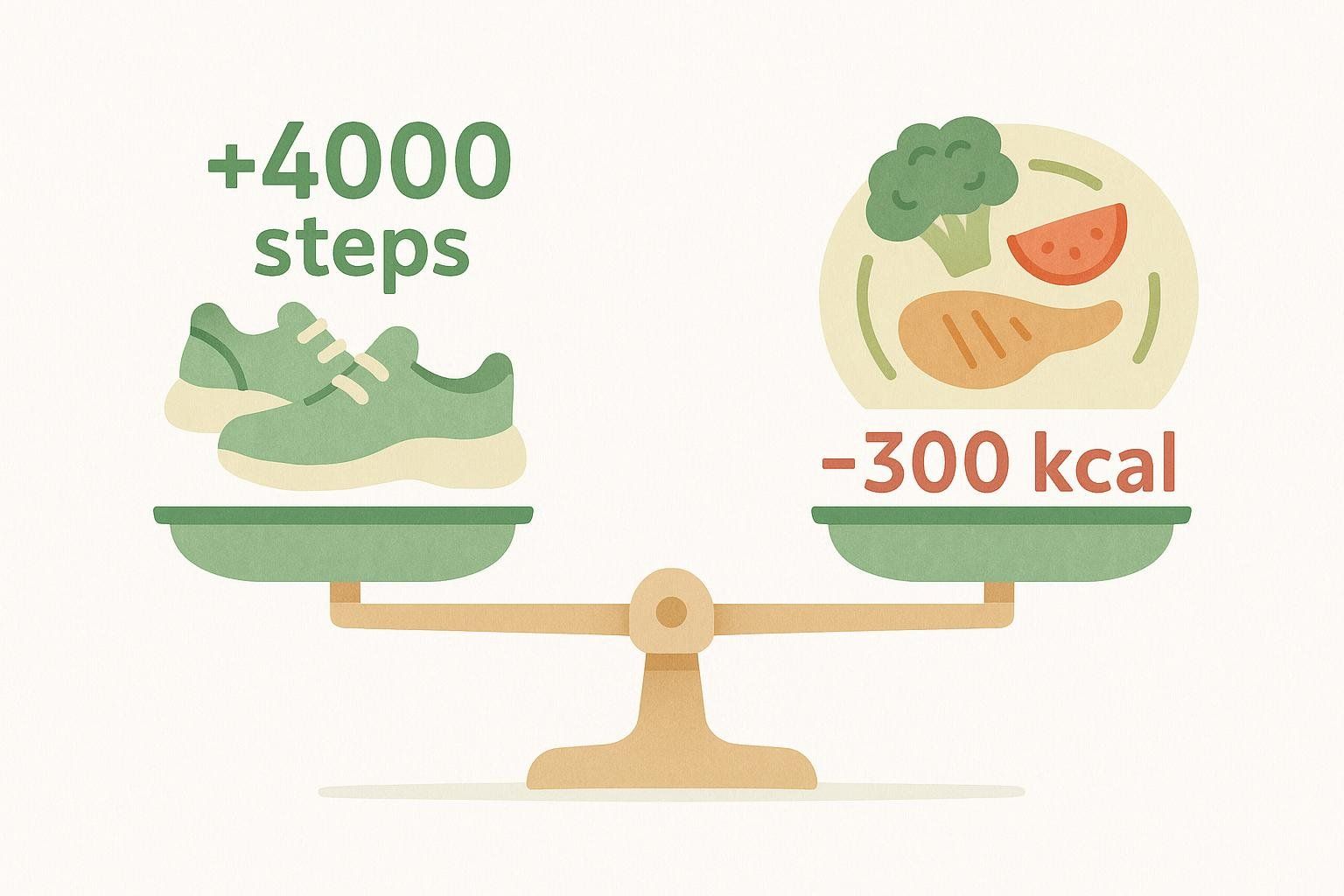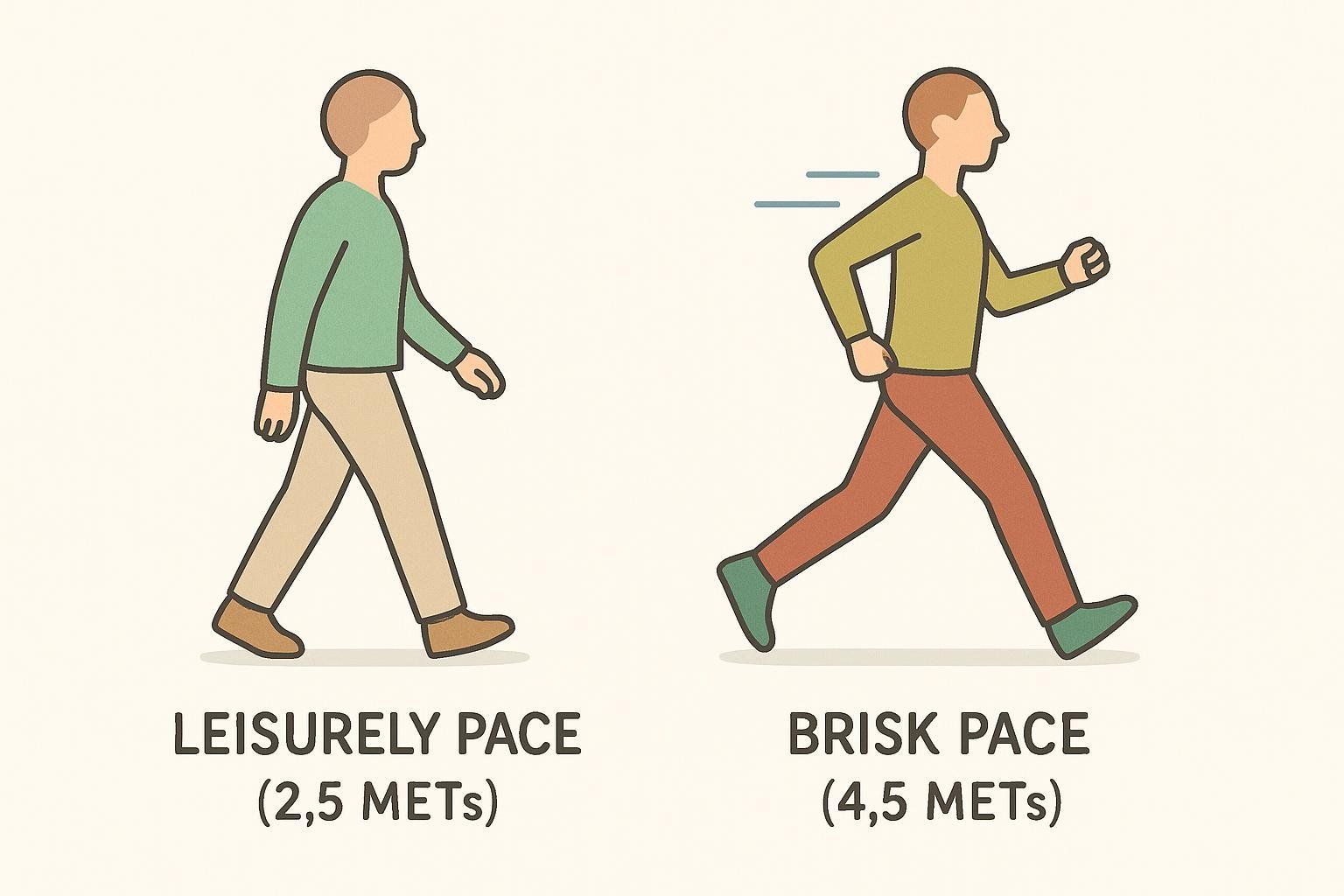How Many Steps to Lose Weight?

How Many Steps a Day Do You Need to Lose Weight? An Evidence-Based Guide
Walking is one of the most accessible forms of exercise—no gym membership, fancy shoes, or athletic background required.
But how many steps do you actually need each day to shed pounds? The popular 10,000-step target feels as universal as Wi-Fi, yet it began as a 1960s Japanese marketing slogan, not a scientific mandate.

Recent research confirms there’s no one-size-fits-all number. Your ideal daily step count depends on factors like current activity level, body composition, and how quickly you want the scale to move.
Quick Take: Most people start losing weight in the 7,500–12,000 steps per day range when that walking is paired with a modest calorie deficit.
Evidence-Based Step Targets for Weight Loss
The table below synthesizes data from controlled trials, epidemiological studies, and CDC energy-expenditure formulas. It assumes an average walking pace of 3 mph (20 min/mile) and a body weight of 155 lb (70 kg).
| Goal | Daily Steps | Approx. Distance | Extra Calories Burned* |
|---|---|---|---|
| Weight maintenance | 5,000–7,000 | 2.5–3.5 mi | 200–280 kcal |
| Modest weight loss | 7,500–9,000 | 3.75–4.5 mi | 300–360 kcal |
| Accelerated weight loss | 10,000–12,000 | 5–6 mi | 400–480 kcal |
| Performance/athletic conditioning | 12,500 + | 6.25 mi + | 500 kcal + |
*Calories estimated at ~0.04 kcal per step for a 155 lb adult. Derived from the Compendium of Physical Activities value for walking 3 mph (3.3 METs ≈ 231 kcal/hour) divided by ~6,000 steps/hour (Compendium—Walking, 3 mph). Heavier individuals burn more per step; lighter individuals burn less.

What the Science Says
- A 2022 Lancet Public Health meta-analysis of 47,471 adults found mortality risk kept falling as steps increased—up to about 10,000 steps for older adults and roughly 12,000 for adults under 60 (Lancet).
- Although that study focused on longevity, the same extra movement also raises total daily energy expenditure, which is the key driver behind weight control.
- A 2022 analysis in Scientific Reports showed adults taking 8,000–9,000 steps per day had significantly lower body-fat percentages than peers logging fewer than 5,000 steps (Scientific Reports).

Bottom line: Around 7,500 steps is where weight-loss benefits reliably kick in, and every additional 1,000–2,000 steps meaningfully increases calorie burn.
Personalize Your Step Goal in 60 Seconds
- Find your baseline. Track steps for three typical days and average them.
- Add activity to create a calorie gap. Each extra ~2,000 steps burns about 80–100 kcal. To reach the classic 500 kcal daily deficit (≈ 1 lb per week), combine additional walking and a small dietary trim.
Example: If your current average is 4,000 steps/day and you’d like to lose 1 lb per week:
• Add 4,000 extra steps daily (≈ 160–200 kcal)
• Reduce food intake by 300–350 kcal
Together, that yields roughly a 500 kcal daily deficit, translating to about 1 lb of weight loss per week.

Reality check: Walking alone rarely covers the entire 3,500 kcal needed for a 1-lb weekly loss—unless you’re clocking ≈ 12,500 steps per day. Pair movement with nutrition for sustainable results.
Re-assess after two weeks using a bathroom scale or, better yet, a BodySpec DEXA scan to see fat vs. muscle changes. Adjust steps upward or downward by 1,000 based on results.
Sneaky Ways to Rack Up Steps Anywhere, Anytime
You don’t need extra hours in your schedule or a scenic trail to inflate your step count. Mix and match these micro-moves throughout the day and watch the numbers climb:

- Park far, not close. Back of the lot = bonus steps.
- Lap the grocery aisles twice. Easy 500-step bump.
- Take the stairs whenever you can. Skip elevators and escalators, or even visit a restroom on the next floor—two flights typically add about 30–40 steps and a quick heart-rate spike.
- Pace the phone call. Walk while you talk.
- Dog-walk double duty. Add a 5-minute loop to the regular walk.
- Lunch-break loop. Ten brisk minutes ≈ 1,000 steps.
- Return the cart. All the way back—your quad burn thanks you.
- Commercial-break circuits. March in place during ads.
- Airport layover laps. One concourse can net 2,000 + steps.
- Water-cooler wander. Small bottle = more refill trips.
- Active waiting. Dentist running late? Walk the parking lot instead of scrolling your phone.
- Kid-chase cardio. Hide-and-seek never felt so fit.
- Groove while you cook. Dance between chopping and sautéing.
String together a handful of these hacks and you can effortlessly add 2,000–4,000 steps without carving out a formal workout.
FAQ: Quick Answers to Popular Step Questions
Can I lose weight with just 5,000 steps per day?
Yes—if you combine those steps with enough dietary calorie reduction. However, studies show > 7,500 steps is a more reliable weight-loss threshold.
Is 15,000 steps too much?
Not if you’re gradually conditioned and injury-free. Athletes and manual-labor workers often exceed 15,000 without harm. Pay attention to joint feedback and footwear.
Do faster steps burn more calories?
Speed matters! A brisk pace (~100 steps/min) corresponds to roughly 4.0–5.0 METs, while a leisurely stroll (~60 steps/min) sits closer to 2.0–2.5 METs (Compendium of Physical Activities). That nearly doubles your energy expenditure at the same body weight. The CDC classifies moderate-intensity activity as 3.0–6.0 METs—so your brisk walk squarely meets the guideline for health-promoting movement (CDC).

Treadmill vs. outdoor walking—any difference?
Calorie burn is nearly identical at the same pace and incline, but outdoor terrain variability can recruit more stabilizing muscles.
Step Plans for Every Lifestyle
Different lifestyles call for different strategies for integrating more movement. Here are tailored step plans for various individuals:
1. Busy Professional (Target: ~10,000 steps)
- Commute hack: Park 0.5 mi from the office (≈ 1,000 extra steps each way).
- Meeting-on-the-move: Schedule one 15-minute walking meeting daily (≈ 1,500 steps).
- Pomodoro pacing: Every 25-minute work block ends with a 3-minute hall loop (~350 steps). Eight rounds = 2,800 steps.
- Errand efficiency: Walk a block lap before driving for small errands.
- For more desk-day movement ideas, see Using Your Activity Tracker Like a Pro.
2. Stay-at-Home Parent (Target: ~7,500 steps)
- Stroller circuits: Two 20-minute stroller walks ≈ 4,000 steps.
- Toy-pick-up squats: Turn clean-up into mini circuits—10 squats + 100 steps per room.
- Dance breaks: Two kitchen dance parties (~1,000 steps each) keep kids happy and calories burning.
- Mall laps: One extra loop before checkout while kids ride in the cart.
3. Active Retiree (Target: 5,000–8,000 steps)

- Split sessions: Three 10-minute walks reduce joint stress while still hitting volume.
- Pole walking: Using trekking poles can reduce strain on knees and add upper-body activation.
- Garden & go: Raking and watering beds add natural steps and functional strength.
- Safety first: Walk well-lit, flat routes and wear reflective gear. If balance is a concern, consult a healthcare provider.
- Book periodic BodySpec DEXA scans to ensure weight lost is coming from fat, not muscle.
Beyond Steps: NEAT & Calorie Burn
Non-Exercise Activity Thermogenesis (NEAT) is the energy you burn doing everything except purposeful exercise—typing, fidgeting, even chewing gum. Steps make up a large chunk of NEAT but not all of it.

- Micro-moves matter: A landmark Science study found that individuals who naturally moved more (standing, pacing, fidgeting) burned about 350 extra kcal/day compared with peers who sat still, helping resist fat gain during overfeeding (PubMed).
- Household chores: 30 minutes of vacuuming adds ~3,000 steps and arm-work calories.
For a deep dive, read Sustainable Weight Loss: Building Habits for Long-Term Success.
Nutrition Synergy: Feed Your Steps
Walking primarily burns fat when you’re in a mild calorie deficit and glycogen stores are modest. Fuel wisely:

- Protein-forward breakfasts – Try overnight oats with Greek yogurt, a veggie egg scramble with avocado, or a protein smoothie with spinach and berries. Aim for 20–30 g protein to stay full. More ideas: The Protein Primer.
- Smart carb timing – Place most starches (e.g., brown rice, quinoa, whole-grain pasta) in meals within two hours of bigger walking blocks to refill glycogen without overshooting calories. Learn more in Nutrition Timing: Does When You Eat Matter?.
- Hydrate early and often – Even 1 % dehydration can drop walking performance. Drink half your body weight (lb) in ounces daily, plus 8 oz for every 30 minutes of brisk walking.
- Fiber fill-up – Target 25–30 g of daily fiber from produce, legumes, and whole grains for satiety and gut health.
Real-World Wins
“I dropped 9 lb in eight weeks by bumping from 6,000 to 11,000 steps and dialing back 250 dietary calories. Seeing my fat mass decrease on the DEXA scan kept me motivated.” — Lou S., BodySpec client (Read Lou S.'s full story)
Need more inspiration? Check out Tony C.'s transformation story.
Next Step: Scan, Track, Succeed
Numbers on a scale can’t tell you if the weight you lose is actually fat. A 6-minute BodySpec DEXA scan maps fat, muscle, and bone so you can fine-tune your walking and nutrition for fat loss—not muscle loss.
Book your scan today and step confidently toward your goals!


